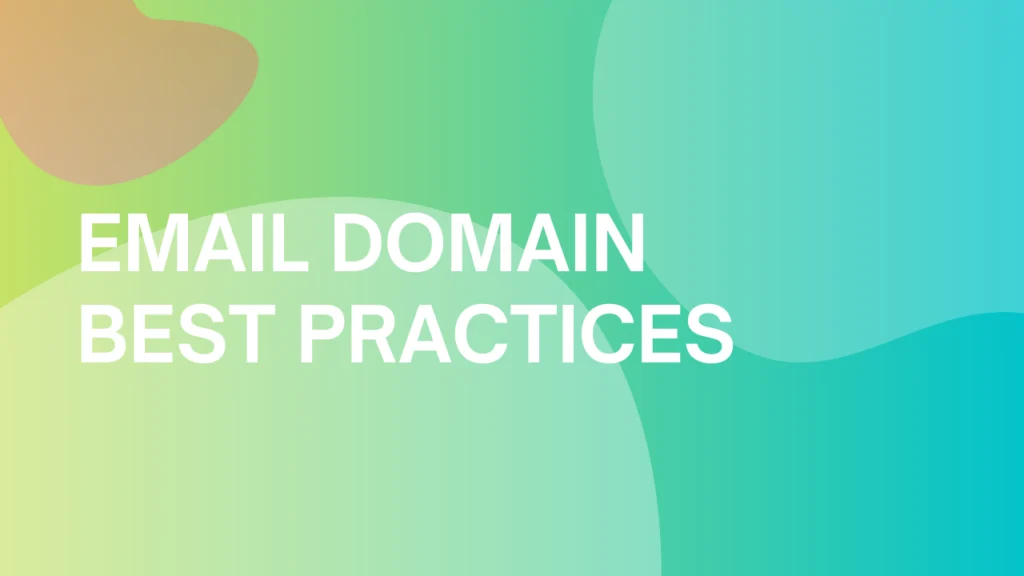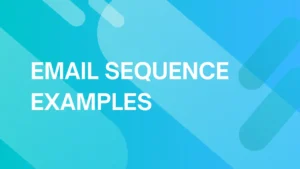
8 Best Email Domain Practices in 2024
You could create the best emails ever to grace the eyes of your customers.
But if those emails don’t even make it to your customers’ inbox, then all your hard work won’t matter.
Let’s look at some simple steps on how to improve your email deliverability with your domain.
1. Create a custom domain
If you’re running a serious business, it’s time to ditch the generalized domain name.
Your domain name is what comes after the “@” symbol on your email address.
Your personal email account is likely managed by “@gmail.com,” “@outlook.com,” “@yahoo.com,” or something similar.
Setting up a business account through your favorite email provider is free, easy, and comes on a familiar platform.
So why should you use a custom domain?
For starters, your business will look more professional with a custom domain.
An email address like “[email protected]” doesn’t make as strong of an impression as “[email protected].”
A custom domain will show your customers that you are a serious, legitimate business and just some random scammer.
Additionally, having your own domain allows you to customize your brand image.
A custom domain opens the door to subdomains, email authentication, tracking, custom envelope domains, and many other essential email deliverability practices.
It also offers you the ability to maintain your domain reputation with ease.
Tip: You can also consider getting an older (or well-prepared) domain instead of a new one.
Older domains with a positive reputation will allow you to send more cold emails right off the bat – and also decrease the chance that your emails will end up in the spam folder.
If you would like to know more about the domain age and how it can impact email deliverability, check out our post about what exactly the domain age is and why it matters in terms of email deliverability.
2. Use multiple subdomains
As your business scales to send more emails, you may want to consider opening up a few subdomains to get out your target number of emails.
Subdomains do not affect deliverability as long as you maintain a positive domain reputation.
You can use subdomains to segment the types of emails you send to your customers.
For example, you can use subdomains like “@promotions.mybusiness.com” or “@updates.mybusiness.com” so Internet Service Providers know precisely what kind of content to expect from the subdomain.
Subdomains free up your primary domain by sending out marketing emails, so your primary domain can focus on customer interactions and sending order updates.
If a subdomain handles your marketing efforts and ends up with some spam complaints, your primary domain reputation won’t suffer as a result.
3. Implement email authentication
Authenticating your email as a verified sender helps Internet Service Providers recognize you as a reliable sender.
These authentications allow receiving servers to quickly verify who you are and catch any cybercriminal attempts to spoof your account.
Email authentication also shows that you prioritize your customers’ well-being and don’t want them to be flooded with spam.
There are three parts to domain authentication, and it’s best to take the time to complete all three:
- Sender Policy Framework (SPF) – A DNS record that allows you to specify authorized domains to send messages on your behalf
- Domain Keys Identified Mail (DKIM) – A DNS record that adds encryption to all of your outgoing messages that allows servers to verify that the content hasn’t been tampered with
- Domain-based Message Authentication, Reporting, and Conformance (DMARC) – A DNS protocol that uses both SPF and DKIM to assist ISPs in validating the authenticity of a message.
4. Maintain a good domain reputation
Maintaining a positive domain reputation is crucial to email deliverability.
If your domain reputation falls below a certain threshold, all of the emails you send will be pushed directly to the spam folder.
Too many spam complaints could get your domain placed on a blocklist, and that’s the last thing you want for your marketing campaigns.
Internet Service Providers are doing everything they can to protect their users from spam and malicious content, so if you have a less-than-stellar reputation, they’ll hesitate to file your message into customers’ inboxes.
Maintaining a positive domain reputation involves practicing good sending etiquette, including:
- Authenticating your emails (as discussed in the previous section)
- Limiting the number of spam reports that you get from Internet Service Providers and consumers
- Providing an unsubscribe button
- Honoring unsubscribe requests
- Using double opt-in measures
Note: If you would like to know what can impact your email reputation, you can read our post about Email reputation with tips and tricks on how to gradually improve it.
5. Send high-quality emails
If you’re going to send your customers an email, make sure it’s an email worth reading.
Since your client gets numerous emails every day, your subject line needs to catch their attention right away.
A good cold subject line can be the difference between an opened and unopened email (but don’t use misleading subject lines).
The “From” line should quickly identify your brand. For example, if you get an email from “Warmup Inbox” or “Sarah at Warmup Inbox” you know the message is coming from us (And hopefully, you love our messages so much that you open them immediately).
But if you get an email from “Sarah Jane”, you might open it to figure out who this person is, or you might just simply delete it because you don’t know any Sarah Jane.
Therefore – Recognition is everything in email marketing.
With emails, you don’t have to worry about integrating SEO keywords, so be creative and have fun with your copy.
At the same time, don’t squeeze a novel into an email.
Get to your point, have an explicit action for your customers to take, and maybe include some information about products or upcoming promotions.
Before you send any email, check that you aren’t using spammy words that might trigger a spam filter.
There are multiple tools online that you can use to see how your message appears to an ISP.
Spam filters are also hyper-conscious of large attachments and too many images/gifs – You may also want to provide an HTML-only option.
While you take a lot of time to craft visually pleasing email masterpieces, some recipients will have a filter that blocks images.
Providing a text version of your copy can make it possible for people to engage with your content.
And last but not least, make sure all your emails are mobile-friendly.
Many customers check their email from their phones, so they’ll likely delete your message if the formatting is off.
6. Monitor your send volumes
If you have a brand new domain, you can’t immediately start sending out as many emails as you want.
It’s essential that you warm up your domain before you reach your target sending amount.
Warming your domain takes about four to six weeks, but it’s so much better for your email campaigns in the long run to take the time to steadily ramp up the number of cold emails you send each day.
Once your inbox is warm, you have to keep it warm.
Extensive periods of not sending emails followed by massive email blasts are huge red flags for ISPs.
If you want to include significantly more emails to your subscriber list, be sure to warm your domain up to that number.
Keeping an eye on the number of emails you send each day can help you catch a hacker sending emails from your domain much sooner than you would without keeping tabs on your sent folder.
7. Check your domain reputation
Keeping an eye on the reputation of your domain can help you to decide whether or not you are ready to start your cold email campaigns (or how long it would take to prepare your domain).
Even though there is not just one straight way of measuring your domain reputation, you can estimate at least it by using one of the popular tools such as:
- Google Postmaster Tools – one of the most popular tools that can show you information about your domain, spam rates, email authentication, or IP reputation
- MX Lookup Tool – the tool is capable of checking whether or not is your domain present in one of the common email blacklists.
- Validity’s Sender Score – VSS measures your email account on a scale of 1 – 100 based on metrics such as blacklist reports, spam reports, etc.
8. Use Warmup Inbox
Warmup Inbox is one of the best tools on the market for maintaining a positive domain reputation.
At its core, the platform warms up your inbox and keeps it warm for ongoing campaigns – it consists of more than 20,000 email inboxes that, as a network, can communicate with each other and consistently improve your email reputation.
But it’s so much more than that.
Warmup Inbox is also capable to provide important data about the inbox such as:
- its domain reputation
- problems with the email reputation
- spam rate of your emails
- presence of your domain in one of the popular blacklists
The platform gives you a real-time tracker of your inbox health, so you know exactly how you’re doing.
Warmup Inbox monitors everything from your DNS settings, blocklists, and ISP reputations – therefore, you can quickly and efficiently increase your deliverability rate and in the end improve your domain reputation.
You can try Warmup Inbox for free (no credit card needed) for 7 days and check out the perks and benefits of this tool.
| Tip: If you are preparing a wide-scale email campaign, you can book a 30-minute free consultation. |



